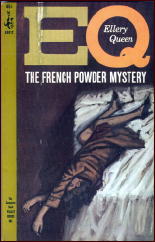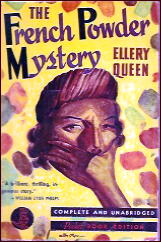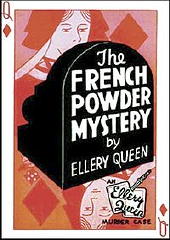Sat 21 Apr 2012
ELLERY QUEEN – The French Powder Mystery. Frederick A. Stokes, hardcover, July 1930. Pocket #71, paperback; 1st printing, August 1940; #45012, 18th printing, August 1964. (All shown.) Several other paperback editions.

I’m sure I’ve told this story before – this blog has been going for over five years now, and it has to have come up at one time or another – but back when I first discovered Ellery Queen – I’m talking well over 50 years ago now – and was devouring them like candy after Halloween, I deliberately held one of them back.
My thinking at the time was along the lines of “If I read this last one, then I’ll have read them all, and how sad that would be, not to have any more of them to look forward to.†The book was, of course, The French Powder Mystery, and it is time, I thought to myself last Tuesday, to finally sit down and read it.
And I’m glad I did. There is the possibility that I might have enjoyed it more when I was in my teens, but enjoy it now, I most certainly did.
Compared with books written today, a lot of readers will not feel the same way. It’s not a book that has a lot of action. It has none in fact, once you exclude a failed raid on a dope house that’s totally abandoned by the time they get there.

If it’s characterization you’re looking for, this early EQ novel doesn’t have a stack of that either, unless you count Ellery twirling his pince-nez glasses while deep in thought, or Inspector Queen’s reaching for his box of snuff when he feels exasperated with either the unruly nature of the case or the multitude of suspects, which is often.
It is a book that begins almost immediately with a murder, followed by 280 pages of small print completely filled with questions, answers, strange discoveries, room searches, alibis, motives, unexplained clues, secret codes and more, including several of Ellery’s discourses on deduction along the way.
There is barely room or time to take a breath. It is delightful, and (I admit) not the kind of book that is popular any more, nor will it become popular again, in my humble opinion. Readers aren’t as willing to sit and think and pay attention to details as they once they did, and boy howdy, do they ever have to in this one.

A bare outline of the plot is in order. The book begins with a body being discovered in a wall-bed that is unfolded for display in a department store window at precisely 12:15 pm. The woman is the wife of the store’s owner, who is in a high-powered business conference upstairs at the time. Missing at the same time is the man’s stepdaughter, who turns out to have several other secrets of her own, making her the chief suspect.
But there are many, many other suspects as well: store personnel, business associates, other family members and former family members. The list of characters at the beginning of the book comes in handy. And as usual in these early Ellery Queen novels, there is a page in which the author challenges the reader. “You have the facts,†you are told. “Who did it, how and why?â€
I am happy, no make that extremely pleased (without bragging) to say that, yes, I knew who did it. Not all of the details, mind you. It takes Ellery Queen the novelist the last 40 pages to go into all of them, in intricate, glorious detail.
It’s an ingenious plot, even if (I confess) a little too complicated for its own good. But I was with Ellery Queen the detective each step of the way, every small fact or clue (except maybe one) brought into the open, discussed and discarded or even better, made part of the unraveling.
Check this one off as finally finished. As I said earlier, I enjoyed myself, I did.
And now I can start over.
April 21st, 2012 at 2:19 pm
“And now I can start over.” I wish I could say that, Steve. Compared to you, I’m just getting started!
April 21st, 2012 at 8:11 pm
Mike and Randy
In all honesty, I don’t really think it was such a great idea to put reading this off for so long. It may have sounded like a good idea at the time, but when you’re young, sometimes you’re not as smart as you think you are.
As I said in the review, I might have enjoyed POWDER more when I was younger. I’m more critical now, and Randy, as you say, when you’re older you see things with a different perspective. It was still fun to read, though.
I do like the starting over part! It isn’t as if the slate has been wiped entirely clean, but enough so that I could read mysteries I read 50 years ago and not even remember who done it. (Sometimes it takes less than a week.)
But of the best and most well-known authors, I’m still not quite finished with most of them the first time around. I have maybe 6 to 10 Nero Wolfe’s I’ve never read, and about a third of the Perry Mason’s, always a favorite of mine. Almost all of Agatha Christie’s books are under my belt; I’ve not read many of those she wrote at the end of her career that I’ve been warned against. The same could be said of John Dickson Carr.
Then there’s Hammett, Chandler, and Ross Macdonald. Please forgive me — I’ve never read DAIN CURSE. I’ve never read PLAYBACK nor THE BLUE HAMMER. John D. MacDonald? I bought all the Travis McGee’s when they first came out but there’s about a third of them I never read. There’s always time later, I thought.
It’s time to go back and finish them off — but what about the myriad authors whose books I’ve read only one or two of — or worse: all the authors I’ve never read?
April 21st, 2012 at 8:01 pm
This reminds me that I was re-reading early EQ not that long ago, but something came up and I didn’t continue. Maybe it’s time to go back and “start over.” I could remember some things from having read them in my teens, but not enough to make them seem repetitive. During a second reading I always can spot things I missed on the first reading.
April 21st, 2012 at 8:30 pm
This is a really good review.
It captures the spirit of the great Ellery Queen.
He’s one of my favorite writers.l
April 22nd, 2012 at 11:15 am
I’m sure there a few Carrs and Queens and Stouts that I haven’t read. The problem is I don’t know which ones they are. I’m not an organized person and I’ve got books scattered all over the place. Occasionally, I’ll pick one up that doesn’t look familiar and wonder if I’ve read it before. As I read, I may begin recognizing things, sometimes it’s, “oh yeah, this is a good one,” other times it’s “oh crap, why did I keep this book?”
I think The French Powder Mystery was the first Queen I read. It was in one of those Signet editions from the seventies. The one with a closeup of a female mannequin’s face with blood coming from the lips. I was intrigued by that cover so I read it. At this point I only remember the department store setting and that I enjoyed it.
April 22nd, 2012 at 11:42 am
I used to spend a lot of time cataloging, organizing and annotating my collection. I haven’t stopped, but I’ve slowed down considerably. Somewhere along the way it’s begun to dawn on me that the purpose of a collection is to read what’s in it, or in the case of movies on DVD, to watch them — not be a curator of them — and an unpaid one at that!
I never thought the covers of the EQ paperbacks put out by Signet in the 70s were very appropriate. I’m sure I can picture of the one you mention. Many of the others were illustrated with good-looking models in skimpy clothing — leading I’m sure to a sad disappointment to anyone picked up to read for that particular reason.
We’re talking roughly 40 years ago now, when the Queen novels were still popular. (I’m assuming that they sold well, otherwise they wouldn’t have kept publishing them.) It’s hard to believe how long ago that was. It was the last serious attempt to make them available in the form of easy to obtain paperbacks. Only a specialized small market publisher would put them out today.
April 22nd, 2012 at 5:19 pm
I’m a firm believer in annotating and making comments in the books I read. I usually slip a piece of paper in the book with such notes as date read and comments concerning the quality of the book, etc.
This reminds me a few years later of my reading experience with the book, so that I don’t make the blunder of rereading a poor novel.
I feel I have to do this because poor or mediocre books are quickly forgotten and I want to read only the outstanding ones. Notes remind me of when I read the book and what I thought of it.
April 22nd, 2012 at 9:40 pm
I agree there is a value in making notes about the date when one reads something. I used to read a number of authors regularly, and kept up with their latest works, but there were times afterward when the only memory I would have of having read a particular book was to find the date penciled on the end papers! The plot had completely vanished from my memory! (Maybe I read too quickly)
April 23rd, 2012 at 10:27 am
I remember who did it in FRENCH POWDER, though I haven’t read or reread the book in several decades. I also remember somebody’s formula for picking the murderer in early Queen novels, and this one fit the formula. There’s also something very ingenious and difficult to pull off in the way the murderer is revealed.
April 23rd, 2012 at 10:53 am
Very seldom am I able to figure out who did it in the old-fashioned whodunits like this one. I used to try when I was younger, but after being stymied by Agatha Christie I would guess maybe ten times out of ten, I more or less gave up and just went along for the ride.
But that doesn’t mean that I’m not paying attention, to the clues and the questions and answers, I mean, and so I’m probably lying when I said “I more or less gave up.” That’s just a cover I use when I fall for an author’s bag of tricks one more time, just like always.
Either way, I admire someone like you who can remember a killer’s identity for so many years. I could have started over with the EQ novels long before now, since I know that only certain parts will come back — such as in THE SIAMESE TWIN MYSTERY, with Ellery and his father driving up the mountain in their Duesenberg and then the wall of flames surrounding the house they’re trapped in at the top. But anything else, there’s not much left, not at the moment, anyway.
The last 40 or so pages of THE FRENCH POWDER mystery are fascinating. I don’t know whether it’s the formula you’re referring to, but having the person I’d decided upon in my mind as the killer, it made the presentation all the more gripping, if such a word could be used in a single scene as long as this one without anyone so much as moving.
Ellery restated all of the clues, his reasoning, and in doing so, peeled away the suspects and discarding them either in groups or one by one. And all the while I’m nodding my head, more and more sure I’d picked the right person.
By the time he’s done with his presentation, the reader is either right there with him — or totally stumped — as everyone has been eliminated as the killer but one — whose name is stated as the last two words of the story. Wonderfully done!
June 18th, 2012 at 4:26 pm
Rereading mysteries is one of life’s great pleasures. I think I’ve been through the Nero Wolfe series about seven times. EQ’s are great fun, as it’s about 50/50 if I remember who done it.
Of course, I owe most of my vocabulary to Leslie Charteris, smiling
seraphically.
January 3rd, 2019 at 11:30 am
[…] The French Powder Mystery occupies a warm spot in my critical heart. It’s the first Queen novel that I read, and perhaps the first classic detective novel not written by Agatha Christie that I […]
September 2nd, 2021 at 2:30 am
[…] Mystery*File […]